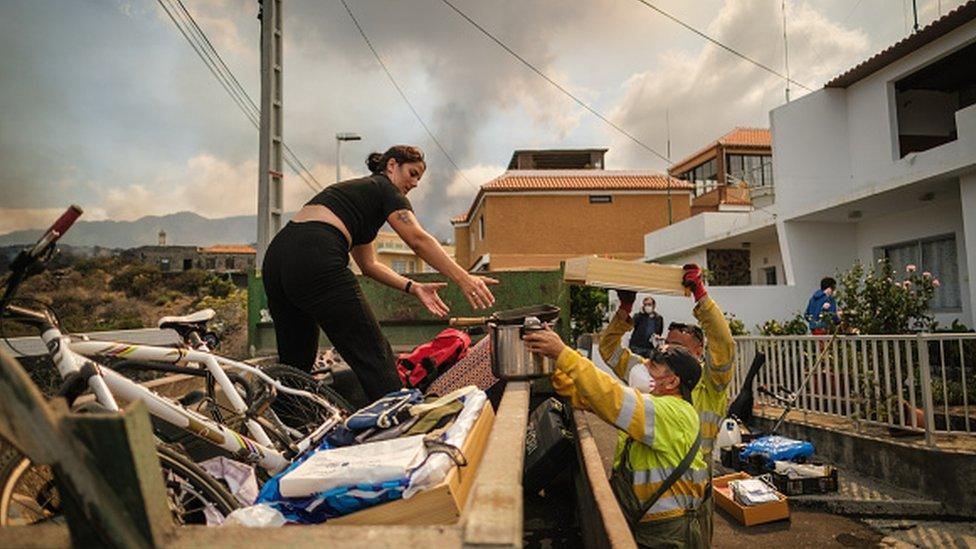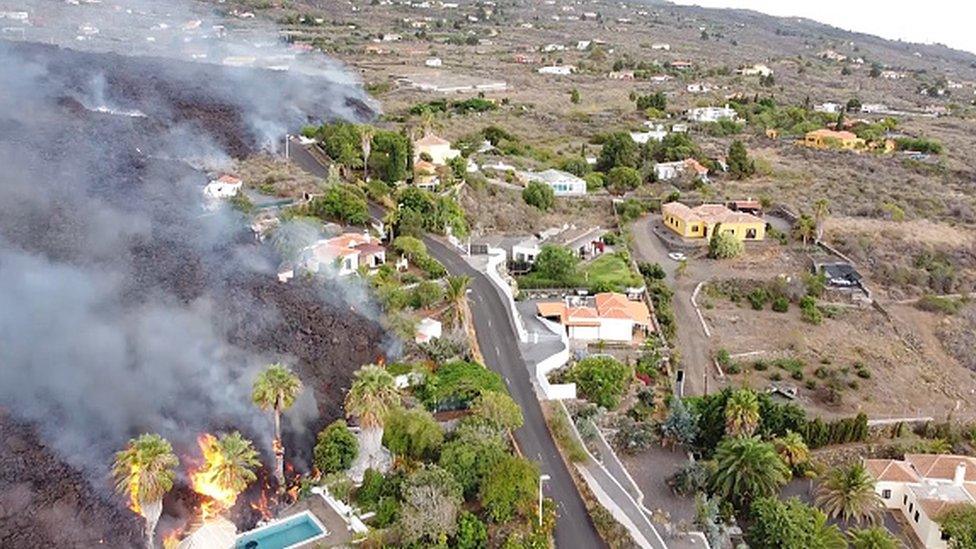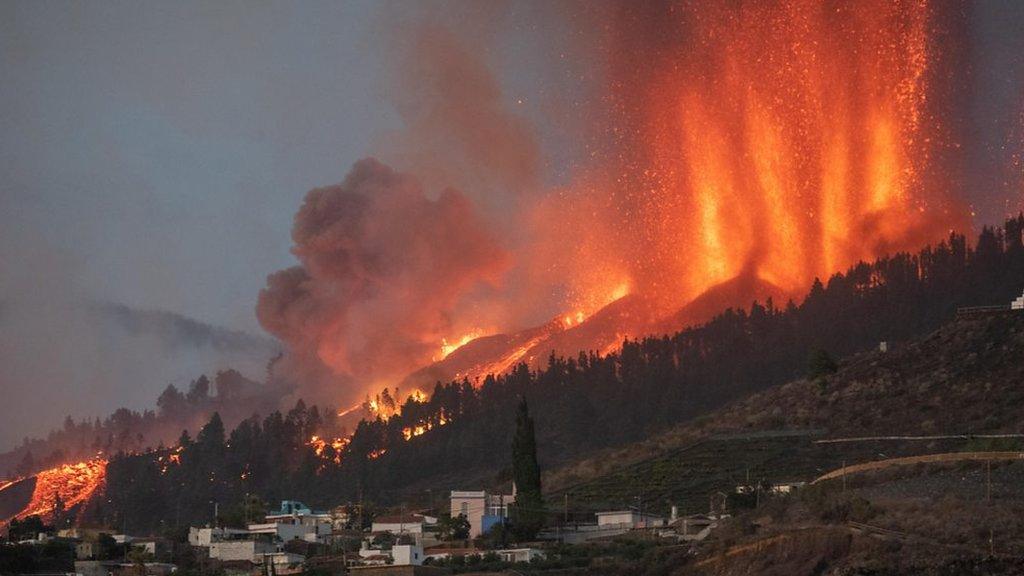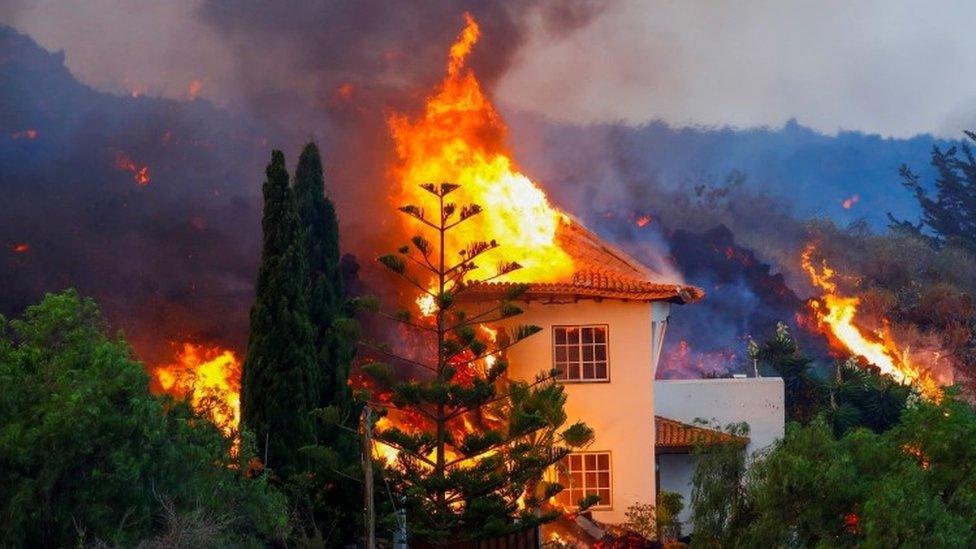Canary Islands volcano: Hundreds more evacuated as La Palma lava nears sea
- Published
Canary Islands: Lava destroys homes on La Palma
An erupting volcano on La Palma in the Spanish Canary Islands has forced authorities to evacuate another village in the path of lava gushing towards the sea.
The evacuation of El Paso was ordered after lava started spewing from a new crack in the Cumbre Vieja volcano.
More than 6,000 people have fled from lava that has buried hundreds of homes since the eruption began on Sunday.
Four earthquakes hit the island shortly after the new eruption vent opened.
Local officials said the lava could trigger a chemical reaction that causes explosions and the release of toxic gases when it reaches the sea.
Marine authorities have established an exclusion zone of two nautical miles (3.7km) at sea, in the area where the lava is heading.
This was done "to prevent onlookers on boats and prevent the gases from affecting people", the president of the island's council, Mariano Hernández, said.
Experts told local media the lava is expected to reach the sea on Tuesday. Residents have been told to stay away from the area, which has been cordoned off by police.
By Tuesday afternoon, the largest lava flow had entered the town of Todoque, travelling at about 200 metres per hour (0.07 mph), authorities said. Families raced to save what they could from their homes in a two-hour window granted by emergency workers.

Residents scrambled to retrieve their belongings on Tuesday as the lava advanced
Regional leader Ángel Víctor Torres said emergency services were powerless to stop the lava's "inexorable" advance to the sea.
In the meantime, the lava continues to spill down the volcano's western flank, destroying everything in its path.
Earlier, the EU's Copernicus service estimated that the lava had covered 103 hectares (1 sq km) and destroyed 166 houses. A satellite image showed the lava's path down the mountain.
Allow X content?
This article contains content provided by X. We ask for your permission before anything is loaded, as they may be using cookies and other technologies. You may want to read X’s cookie policy, external and privacy policy, external before accepting. To view this content choose ‘accept and continue’.

Citing the mayor of El Paso, Sergio Rodríguez, the Cadena SER radio station reported, external that as many as 300 homes had been destroyed by the lava so far.
Currently, no casualties have been reported, but footage showed lava overwhelming roads, farms and swimming pools on the island, which is popular with tourists.
There were mandatory evacuation orders for four villages, including El Paso and Los Llanos de Aridane, and temporary shelters have been set up.
'This is a catastrophe'
"We are very worried because we don't know when we will return home," one evacuee, Ana Guadalupe González, told Spanish public radio.
Fearing her home might be engulfed by lava, she said she "ran out of there and left many things, such as our pets".
Another local named Laura told Cadena SER radio she and her family were given warning about the eruption but had no time to prepare for the evacuation.
"My house is not affected, but my neighbours have lost their houses, their small businesses. This is a catastrophe," she said.

Lava from the eruption has gushed through the landscape since the eruption started
Spanish TV reported that one primary school had been destroyed by the lava. The director of the Los Campitos school said the families of at least half of the school's 23 children had also lost their homes.
Domingo Guerra, a priest from El Paso, told La 1 TV he had lived through previous volcano eruptions on La Palma in 1949 and 1971.
"The situation now is much more worrying, disturbing and overwhelming," he said.

Spain's Prime Minister Pedro Sánchez has delayed a trip to a UN summit in New York while he oversees ongoing rescue efforts.
Aviation authorities said the eruption had not affected air traffic in the Canary Islands.
The volcano lies in the south of La Palma island, which is home to around 80,000 people.
It last erupted 50 years ago in 1971. Scientists are unsure how long this eruption will last.
A spokesperson for Spain's National Geographic Institute told the BBC that past eruptions on La Palma have lasted between 24 and 84 days.
So far, the Cumbre Vieja eruption has emitted between 7,997 and 10,665 tonnes of sulphur dioxide (SO2) per day into the atmosphere, according to the Vulcanological Institute of the Canary Islands (Involcan).
That gas reacts with oxygen and moisture in the atmosphere to produce vog, volcanic smog, and acid rain, science journalist and volcanologist Dr Robin George Andrews told the BBC.
But the biggest threat to residents was the lava, he said.
The dangers of lava
When lava comes into contact with ocean water, it produces a gas plume known as laze.
A portmanteau of lava and haze, laze forms through a series of chemical reactions as hot lava boils the colder sea water.
"It creates a steam of hydrochloric acid, water vapour and bits of ash," Dr Andrews said. "Obviously, it's not good to breathe in."
Laze plumes can cause eye, lung and skin irritation but should not be a problem if residents keep their distance, he said.

A Copernicus satellite image shows the eruption on the west slope of the Cumbre Vieja
Volcanic explosions were also possible, he added, because lava entering sea water creates "a pressure-cooker situation" that "might fling out volcanic debris".
There was an incident in Hawaii where a chunk of molten rock, known as a lava bomb, crashed into a tourist boat off Hawaii's coast in 2018, injuring 23 people.
Dr Andrews said the cordon in the sea off La Palma indicated "they're taking this seriously and not even willing to risk someone even getting near it".
Related topics
- Published19 September 2021

- Published20 September 2021
